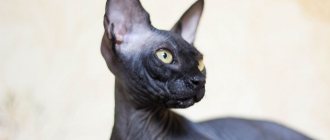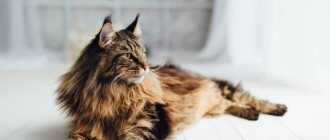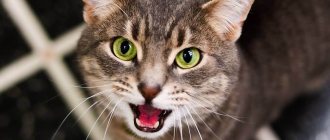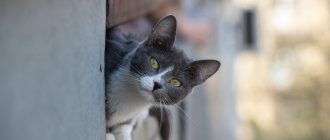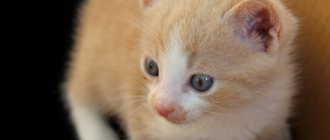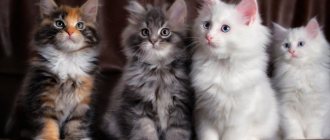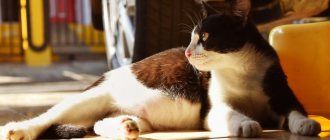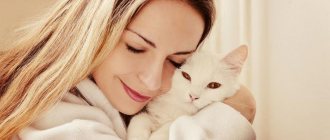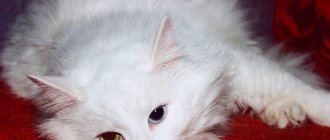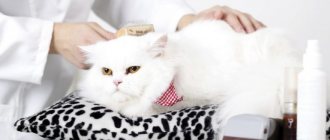The size and physiological maturation of animals depend on a large number of different factors. To know exactly to what age cats grow, it is necessary to take into account their breed, the functioning of the endocrine glands and their general health. Proper care and the creation of suitable conditions can affect the growth of a pet.
British kitten weight table by month
The weight of a British cat, as can be seen from the table, changes unevenly with age: the animal’s muscle and fat mass grows most rapidly in the first month, then slows down. At one year of age, the British pet actually reaches its maximum weight, and the weight stabilizes at 2.5 years.
| age | female, kg | male, kg | peculiarities |
| newborn | 0,07–0,15 | 0,08–0,15 | newborn kittens of the British breed are quite large |
| first week | 0,1–0,25 | 0,25–0,3 | a nursing cat needs to be well fed, food must be rich in vitamins and balanced, so that the cubs develop fully |
| second | 0,15–0,35 | 0,35–0,4 | by this time, British kittens should weigh approximately 1.5 times more than at birth, the eyelids of large and developed cubs open |
| third | 0,2–0,4 | 0,4–0,65 | you can gradually introduce complementary foods, especially if the litter is large and the kittens are weak |
| first month of life | 0,25–0,6 | 0,55–0,7 | as complementary food, they give boiled beef or chicken minced in a meat grinder or blender, sea fish fillet, soft canned cat food, cottage cheese, boiled yolk |
| 2 months | 0,45–0,9 | 1–1,7 | |
| 3 | 1–1,5 | 1,5–2,5 | if the cubs are still fed with mother's milk, then the feeding should be more balanced and rich in vitamins |
| 4 | 1,8–2,4 | 2,2–3,9 | |
| 5 | 2,2–2,9 | 2,6–4,3 | Before becoming an adult, a British kitten must gain the same number of kilograms as at 5 months of age |
| 6 | 2,3–3,6 | 3–5,4 | |
| 7 | 2,4–3,8 | 3,3–5,6 | |
| 8 | 2,5–4 | 3,5–6 | |
| 9 | 2,5–4,2 | 3,8–6,4 | |
| 10 | 2,5–4,3 | 4,1–6,6 | |
| 11 | 2,5–4,3 | 4,2–6,7 | |
| year | 2,5–4,5 | 4,5–7 | Once a British cat has become mature, it is prohibited to give fatty meats, smoked meats, fatty dairy products, river fish (they may contain helminths), bones (they are poorly digested in the stomach) |
How much should an adult British cat weigh?
You should not think that the weight of an adult British cat does not change. The weight indicators of mature individuals are insignificant, but still increase. Moreover, castrated individuals show a more rapid increase in body weight.
If a non-sterile one-year-old pet has an average weight of 4.5 kg, then a castrato weight norm is 3–6 kg for a female, 5–9 kg for a male.
NOTE! An adult British cat, provided it receives high-quality balanced food, gains weight by 50–100 g per day.
The table shows the normal weight of adult British cats and cats.
| age, years | female, kg | male, kg | height at withers, cm |
| 1 | 2–4 | 4–6 | 15–22 |
| 2 | 2,5–4,5 | 4,5–4,8 | 18–25 |
| 3 | 2,8–4,8 | 4,7–7 | 22–27 |
| 4 | 3,8–5 | 5–7,5 | 25–30 |
| 5 | 4–6 | 5,5–8 | 28–33 |
A healthy British cat should have a proportionate body. The ribs, pelvic and sternum bones should not protrude. The waist in the absence of obesity in British pets is clearly visible. The fat layer is moderate, through it you can feel the abdominal organs and chest.
INTERESTING! British cats with a solid coat color weigh on average more than their patterned counterparts. And this is the breed norm.
What kind of hair do British cats have?
Special attention should be paid to British wool. Thanks to the harsh living conditions of the past, these animals have acquired an excellent coat with a very dense and thick undercoat.
Despite the fact that the structure of the wool itself is thin, it feels quite elastic and soft to the touch. Therefore, representatives of this breed are often called plush. In addition, the coat of British cats is distinguished by beautiful, shiny colors. British cat care and maintenance >>
At the moment, there are about 60 colors that the British have. It can be any solid color, smoky, tortoiseshell, tabby, chinchilla, bicolor or colorpoint. The most common among them are solid blue, as well as two-color tabby and chinchilla.
Important! The British Shorthair's coat should be the same length all over the body. As a rule, it does not exceed 2.4 cm
A healthy British cat never develops tufts of fur, so he can easily take care of his coat on his own.
What are the dangers of being underweight?
In emaciated British cats, the ribs, sternum and pelvic bones protrude greatly, the limbs are thin, frail, and the stomach is sunken. Due to lack of nutrients, the hair sheds greatly. If you feel the sternum, there will be no fatty layer on the bones.
The most common reason that a kitten does not recover is a lack of mother's milk. This happens in a large litter, when not all cubs get their mother's nipple during feeding.
The owner must ensure that each kitten eats. If a cub lags behind its brothers in weight, then it needs to be moved more often to its mother’s nipples.
RECOMMENDATION! It happens that a mother cat’s milk disappears. In this case, kittens must be pipetted with high-fat, unsweetened concentrated milk.
If, despite all measures and efforts, the weight of the British kitten does not increase, then this is a signal of illness. The pet must be taken to the veterinary clinic immediately.
Sometimes owners note that in 8-9 month old British kittens the weight stays the same, or even drops slightly. There is no need to worry, the reason is hormonal changes in the body associated with puberty.
An adult cat's weight should not drop. In an exhausted animal, the functioning of internal organs is disrupted and mental disorders occur. The cat becomes nervous, anxious, and moves little.
The following problems may occur due to lack of weight:
IMPORTANT! With a deficiency of vitamins, mineral elements and nutrients, British cats develop pancreatitis, cholelithiasis and urolithiasis, and defecation is impaired.
Care
British cats should be taught to use a comb from childhood, as the fur on the belly is quite difficult to comb. They have a fairly good, thick undercoat, so for this procedure it is better to use a slicker brush with metal teeth rounded at the ends. Brushing twice a week is enough for the animal to get used to the “beauty session” and enjoy it. During shedding, you need to brush more often. The British breed is the only breed that enjoys brushing and stroking against the coat.
Britons give birth to very large cubs and, as they grow up, they become very active with a large source of energy. The cat takes very touching care of the kittens and almost never lets them go. The cubs open their eyes after about a week. Kittens grow very quickly and become large and dense, but they do not get fat. The cat grows until about four years of age and reaches full bloom at five years of age.
When choosing a British kitten, be vigilant. The ideal age for a kitten to be rehomed is between 12 and 16 weeks. British cats usually have small litters, as the kittens are born strong and large. By three months, they not only have good physical development, but also acquire social skills.
On average, British Shorthair cats live 18-20 years. A British cat can be considered an ideal acquisition for a number of reasons. They exude kindness, they have a pleasant character, a presentable appearance and a calm temperament. All this ensured this breed great popularity. Due to their character and low maintenance requirements, cats are ideal for owners who spend all their free time working.
It is worth keeping in mind that this description is typical for the breed as a whole and may not completely coincide with the characteristics of a particular cat of this breed!
What are the dangers of obesity?
You can tell that a cat is obese by its sagging belly. Because the fat layer is too thick, the costal and vertebral bones cannot be felt. An obese animal moves slowly and ignores active activities.
ATTENTION! An obese cat needs to be examined at a veterinary clinic for prevention, as there is a high probability of developing diseases of the heart and vascular system, as well as inflammation of the joints.
Excess weight greatly affects the health of a British pet. The most common pathologies:
Golden chinchilla cat. Description, features, care and price of the breed
A breed named after its color. The first chinchilla was born in England and was silver. The cat's name was Shinny. The gray color along her hairs was distributed as a gradient, that is, it smoothly changed tone from light to dark.
In nature, this color is characteristic of chinchillas, a type of rodent. Shinny, named after them, gave birth to offspring. One of the kittens became famous and won dozens of regalia at cat shows.
At the Natural History Museum in London, one of the stands is dedicated to the winner. However, it does not reflect the development of the breed. By the middle of the 20th century, cases of the birth of not silver, but golden chinchillas had accumulated.
Shades of yellow were distributed in a gradient along their hairs. Along the top of the coat it is almost white, and in the undercoat it is richly apricot. Interestingly, this color is found in cats of several breeds.
Tips for maintaining normal weight
To keep a British cat's weight within normal limits, owners need to maintain a balanced diet:
A kitten is taught to eat cereals and vegetables from an early age. The diet of an adult British cat should consist of 10–15% vegetables and cereals, 85–90% meat and fish.
Also, we must not forget about regular physical activity. To prevent a cat from developing obesity, the owner must engage it in active games every day.
High-quality and balanced nutrition, an abundance of vitamins and nutrients, an active lifestyle - these are the main factors for the full development of a British pet.
The owner should weigh the kitten at the same time every day in order to notice weight deviations in time. If the development of the “British” does not correspond to his age, then there is no need to hesitate in going to the veterinarian.
Source
Russian nurseries
Where can you buy a British kitten in Moscow:
- Tamaky*ru, Cattery of British cats Moscow. They offer British Shorthair kittens of different colors and ages with vaccinations and certificates.
- Style of Provence, nursery of British cats by Lyudmila Mikheeva. They have been breeding professionally for 10 years. Pets are offered vaccinated, trained and with a set of bright photographs.
- Joy Land, a British cattery, breeds pets of blue and lilac, cream and cinnamon colors.
Before you bring the furry miracle home, you need to remember: an animal, not a toy. This is a living creature, small and defenseless. And it is the owner’s responsibility to take care of it.
How old do cats grow?
Scots
Among the Scots, one can distinguish lop-eared and straight-eared representatives. If we look at the general characteristics of the breed, we can see that by the age of three, cats’ muscle mass, skeleton, as well as eye color and coat color are finally formed.
Fold
Scottish Folds develop to their maximum by the age of three. The weight of an adult male can reach 6.5 kg, and females 4.5 kg. By that time, they are already fully physically developed and ready to reproduce.
Straight-eared
Representatives of straight-eared Scots are somewhat larger than their fold-eared counterparts. Their growth rates are not much different, but their final weight is yes. Males by the time of their final development reach 7 kg in weight, while females can weigh 6 kg. This is due not only to nutrition. Genetics plays a big role here. Straight-eared Scots rarely have deviations in terms of height. And if the cat is also a purebred, then we can safely say that he will grow into a fat teddy.
British
The British begin to actively grow already at the age of one month. By then, their teeth have formed and they can eat on their own. Since, due to the characteristics of the breed, these felines are prone to obesity, their diet should be given increased attention.
Their musculoskeletal mass is finally formed by 2-2.5 years of life. But even after this they can continue to develop, until they reach the age of three. The weight of an adult male can reach 8 kg, and a female 6 kg. If you add two kilograms to each indicator, you can get the weight that these representatives of the feline family can gain after castration or sterilization.
Regular cats
Cats and male cats without claims to purebred also have their own developmental characteristics. As a rule, they reach the bulk and growth by two years. As mentioned earlier, a lot depends on heredity, nutrition and lifestyle. Sedentary animals that prefer to spend most of their time lying on the sofa can reach a weight of up to 9 kg. Moreover, these can be both males and females. Especially when it comes to castrated or sterilized cats.
In the latter case, special attention must be paid to nutrition. It will be better if you feed the animal with special dietary foods that have a balanced combination of nutritional components and are easily absorbed by the body.
Maine Coon
There is a misconception that adult Maine Coons can reach up to 15 and even 25 kg in weight. However, despite the large growth (up to 100 cm in length) of the animal, the weight of an adult male does not exceed 12 kg, and the female is even less - 8 kg. They are born larger than kittens of other breeds: babies can weigh from 120 to 140 grams. And this only happens if there are several kittens in the litter. If the baby was born alone, his weight may be 160 grams.
Maine Coons grow up to three years old, like most purebred cats. Closer to this age, their muscles actively develop: their chest becomes wider, and their shoulders and paws become stronger.
Bengal
Bengal babies weigh from 70 to 120 grams at birth. They grow actively until 9 months, after which the rate of their development decreases. In females at this age it can generally stop, while males can grow up to two years.
The maximum weight of females does not exceed 5 kg, males - 8 kg. And the body length can vary from 50 cm to 1 meter.
Sphinxes
Sphynx kittens are born tiny and helpless. Their birth weight is only 85 grams. But at the same time, after three days they are able to independently find their mother’s nipple and, with the movement of their paws, cause the release of milk. Sphynx cats are considered one of the smartest cats.
They reach sexual maturity by 6 months of age. But if the first mating occurs at this age, the development of the body’s reproductive system stops. Therefore, it is not recommended to mate a Sphynx until at least a year old. In general, sphinxes can grow up to 2-2.5 years. This can be seen especially well by the increase in the shape of the head and the expansion of the skeleton.
Abyssinian
Abyssinian cats are not much different in size and weight from ordinary ones. This in no way concerns their appearance, but only their general parameters. In general, male cats grow until they are about two years old. Their weight, like most felines, depends on diet, genetics and whether the cat is spayed or neutered.
The weight of an adult female is 5-6 kg, a male is 6-7 kg. But under certain conditions it can be 8 kg. There is no need to worry about this: breed standards allow this option.
Source
Basic information, features, facts
Weight of a British cat, to what age do they grow, life expectancy?
An adult Briton weighs from 5 kg – 9 kg. Girls are smaller and weigh from 3.5 kg to 7 kg. Spayed and neutered animals gain slightly more weight. It all depends on proper nutrition.
Table - weight (g) of a British kitten by month
| Age | Boys | Girls |
| Newborn kitten weight | 65 — 140 | 60 — 130 |
| 1 Week | 230 — 270 | 120 — 240 |
| 2 weeks | 330 — 410 | 145 — 350 |
| 3 weeks | 390 — 620 | 200 — 410 |
| 4 weeks | 1 month | 545 — 740 | 245 — 550 |
| 2 months | 990 — 1650 | 440 — 900 |
| 3 months | 1450 — 2600 | 1000 — 1450 |
| 4 months | 2000 — 3800 | 1600 — 2300 |
| 5 months | 2500 — 4200 | 2100 — 2800 |
| 6 months | 2200 — 3500 | 2900 — 5300 |
| 7 months | 3200 — 5500 | 2300 — 3800 |
| 8 months | 3450 — 5900 | 2450 — 4000 |
| 9 months | 3700 — 6300 | 2400 — 4200 |
| 10 months | 4000 — 6600 | 2400 — 4300 |
| 11 months | 4200 — 6700 | 2400 — 4400 |
| 12 months | 1 year | 4400 — 6900 | 3000 — 4500 |
| Adult | 4500 — 8000 | 3500 — 5400 |
| Castrated | sterilized | 4500 — 9000 | 3500 — 6000 |
How many years do they live? The life expectancy of a British cat is influenced by certain factors: the presence of genetic diseases, proper feeding and care, vaccination, veterinary examinations, indoor or outdoor keeping, castration | sterilization.
Lifespan 12 – 16 years.
Basic physiological data of healthy cats, briefly
Body temperature (rectal): 38 – 38.5 ⁰C.
Breathing rate: 10 – 20 / min.
Duration of estrus: 10 – 12 days.
Favorable period for mating: during estrus.
Duration of pregnancy: 55 – 65 days, depending on the breed.
Age of a cat by human standards
| 18 months - 20 years | 9 years – 52 |
| 20 months – 21 years old | 10 years – 56 years |
| 22 months – 22 years | 11 years – 60 years |
| 2 years – 24 years | 12 years – 64 |
| 3 years – 28 years | 13 years – 68 years |
| 4 years – 32 years | 14 years - 72 |
| 5 years – 36 years | 15 years – 76 years |
| 6 years – 40 years | 17 years - 84 |
| 7 years – 44 g. | 19 years - 92 |
| 8 years – 48 years | 20 years – 100 years |
Behavior, character, habits
The British Shorthair is soft and calm, an excellent family companion. Loves affection, but is not the “me, me, me” type of cat. Will follow you around the house throughout the day, settling nearby wherever you go. These cats are unlikely to lie on your lap and do not like to be carried or held. Will enjoy the company of their human family members, spending time playing or sleeping in the same room. They are felines with a moderate level of activity. Energetic as a kitten, but begins to calm down when he is one year old. More mature British Shorthairs are usually “coolies”, but older males sometimes act like goofballs. When running around the house, they can sound like a herd of elephants.
Behavior in public places, instincts.
Each kitten has its own character and habits. British cats are calm towards strangers. One will make contact immediately, the other will observe from the side. If a cat rarely goes to public places or transport, he will be wary and hide - this is a normal reaction to an unfamiliar environment.
The British are an artificially bred breed, but the instincts have not gone away. British cats are excellent hunters, tested at the dacha and based on reviews from owners; Often cats need help during childbirth.
Attitude to extraneous sounds.
Extraneous sounds, rustles, objects arouse interest, and as a result the cat goes to investigate. At such moments, you need to come up and support, stroke and calm her, and explain. When the vacuum cleaner is running, they go into another room, there are cats from our litters who are absolutely calm about the vacuum cleaner, the new parents of the kittens said.
Behavior in the house, how to properly organize space.
The British love to play, the most active age is up to 4 months, they remain playful for up to a year, after which they become adults, important, calm, sleep and watch more. Based on observations of our pets, I can say that they love high play structures and sleep in houses only when it’s cold. Britons are large and weighty, so the complex with the scratching post must match. Among the toys they like are “flyers” with feathers or leather ropes, bouncy balls, and mice; mazes, boxes, etc. The main thing to remember is that the toy must be safe. British adults love to spend time with their owners at the computer and TV.
Toys, treats, suitable types of entertainment, is training possible?
Kittens love toys, especially new ones; if there is no new one, they can invent a toy for themselves: they will steal a hair tie (very dangerous because they can eat it), a candy wrapper, a piece of paper, or a cap from a plastic bottle. One of our graduates in her new house got used to removing a corner from the baseboards and moving it around the house.
They won’t refuse “sweets”; our pets have treats: vitamins, wet food and canned food.
Training is possible; in our nursery, from childhood, we teach him a scratching post, a name, a tray, and the word “no.”
Solitary behavior, sabotage, useful activities.
The British tolerate loneliness calmly, of course we are talking about the time when the owners are at work, mostly cats eat and sleep at this time, waiting for the evening.
If a Briton is offended, he will definitely show his dissatisfaction, he may be harmful, this will happen right away, he will not accumulate resentment.
British cats are for any movement in the house, for any repairs, they love to take part in it.
Communication with other animals, children, owner. Aggressiveness.
If a British cat is pedigree, she has pedigree titled parents, then 99%, she will be balanced, because... unbalanced ones are disqualified from examination and should not go into breeding, so it is important when buying a kitten to contact official nurseries.
Our beauty came to us before the birth of the child, but she accepted her daughter calmly, even slept with her in the crib. The kittens already appeared with the child, grew up, played together.
If the cat is “loner”, it will react aggressively to any strange animal.
It all depends on the character, one is more emotional and loves to talk, the other is calm.
If a British cat is not bothered by anything, it will behave calmly; if the cat has problems, it will definitely show it.
Several pets in the house, intersexual relations, attitude towards other pets.
While the mother is feeding, she treats the kittens normally, when the kittens grow up, she begins to be loyal to someone, while others can be annoying. Cats do not have the concept of mother-son; a cat-son can breed a cat-mother. Cats and cats can live together if they psychologically tolerate this living well. They are separated during estrus.
They bought kittens from us for a house where dogs lived, they all adapted and got along fine.
Attitude to heat and cold.
The British don't like hot beds. In summer, they often look for cool places (floors, tiles); in autumn and spring, before heating, vice versa. They sleep where they want and how they want, there is no one favorite place.
In what situations do they vote? How clean?
Depends on the character. The cat wants to talk - talk to him.
The British are very clean, they demand clean bowls and fresh water - this is right. They don't like to swim, but they tolerate it steadfastly.
Health, care
The British breed is healthy and does not suffer from many genetic problems. May have diseases: hemophilia B, hypertrophic cardiomyopathy, polycystic kidney disease, gingivitis.
Brush your teeth to prevent periodontal disease. Daily oral hygiene is best, but weekly brushing is better than nothing. Trim nails weekly. Wipe the corners of your eyes with a cotton pad containing a special solution to remove any discharge. Use a separate cotton pad for each eye to prevent infection from spreading.
Check your ears weekly. If they look dirty, dry them with a cotton pad and ear spray.
Correct British wool is similar to a mouton (plush), short, elastic, with a good undercoat. With a properly balanced diet, maintenance is minimal. We bathe cats once a year, brush them a couple of times a week with special combs or a rubber comb. During the molting period, you have to brush more often. The main thing is to choose the right care products and balance your diet. You cannot use slicker brushes with fine teeth without protected ends, you cannot wash them frequently, it is better to use special napkins for wool.
Omnivorous, prone to obesity.
The British are not very active; they prefer to lie down. The tendency towards inactivity means that you need to play with your cat regularly for its health and mental stimulation.
The British are picky eaters; if you find good food, the problem will go away. Neutered or sterilized cats are prone to overeating and obesity. We are responsible for those we have tamed and must monitor what we feed and in what quantity. It is better to use special feed, following the norm depending on the weight of the animal.
Read more about feeding here.
Age at which cats grow
Full physiological maturation of the animal occurs with puberty. However, growth continues for some time. The average age at which cats stop growing is from 1 to 3 years. The exact time depends on several internal and external factors, including the characteristics of the content and breed. Height does not include obesity.
There are 5 stages of cat maturation:
Starting from 1 year, the cat is considered independent.
Factors affecting dimensions
The growth and maturation of a cat is influenced by external factors and features of physiological development. These include:
- Breed is one of the most important factors affecting the height and weight of an adult animal, as well as the age at which it reaches adulthood. In outbred domestic cats, the genotype is most often mixed, so it is unlikely that it will be possible to determine the exact timing of development. Some kittens grow up to 3 years old, while others reach their maximum height and weight by one year.
- Heredity - the size of an animal largely depends on the size of its parents. It is extremely rare for small cats to give birth to large kittens.
- Gender of the animal - males always grow larger and heavier than females.
- Living conditions - growth is influenced by a comfortable room temperature, sufficient light, good restful sleep and the baby’s nutrition.
- State of health and presence of any diseases. The pathology can be any - somatic, infectious, parasitic or genetically determined. The correct functioning of the endocrine glands is also important.
- Physical activity and lifestyle - the more a kitten moves and plays, the better it grows. His body develops proportionally, and his weight is normal for his age and breed.
- Castration, especially performed in adulthood. Cats that are sterilized at the age of 2-3 years and older grow larger than those that were neutered before a year or were not sterilized at all.
Early mating before the age of 1 year leads to a slowdown or complete cessation of the animal’s growth.
Stages of growth
There are several phases of growth in pets. The active growth phase usually lasts until the end of maturation, approximately 10-15 months (depending on the breed). Large breeds (for example, Maine Coons, Bengals, Servals) grow up to 2 years, and smaller ones - up to 3 years.
Important! At each stage of growth, the cat must be provided with favorable development conditions by the owner so that there are no developmental delays or deviations.
From birth to 4 days
This is the very first period from the moment the animal is born to 4 days. The period is called neonatal. The period is characterized by weight loss in babies.
Second period
The period is called suction. It lasts 3-3.5 weeks. The main trends of this stage: weight gain, active growth.
Transition stage
A longer period of 4 to 6 weeks. The main trends of the stage: active growth of all organs.
Post-suction stage
The teenage period is calculated from 2 months until the end of the cat’s development, which depends on the breed. The peak period coincides with the age of 3-5 months. When the teenage stage ends, cats stop growing, and cats increase by a maximum of 2-3 cm.
Important! By the age of 1 year, cats grow in length and breadth. After a year, they only grow in width until they gain the weight characteristic of their breed.
Osteochondrodysplasia
The genetic disease is osteochondrodysplasia of Scottish fold cats (OSF), a common, incurable disease that affects the bones and joints of the animal. Caused by the presence of an individual gene for “loop ears”, which is specific to the Scottish Fold and Highland Fold. Diseases of Scottish Fold cats appear in newborn kittens in the first months of life.
OCD, a hereditary disease, is transmitted regardless of the sex of the animal from offspring to parents. To protect animals from the transmission of heredity, mating within the Scottish Fold and Highland Fold species is prohibited; interspecific mating is allowed only within the Scottish breed with straight-eared cats - Scottish Straight, Highland Straight. If you follow the rules of crossing, the risk of developing DCD is greatly reduced.
When OCD manifests itself, bone tissue grows around the joints, and the bones and cartilage of the entire spine skeleton, starting with the tail, and limbs are affected.
It is impossible to cure a gene disease at the present stage; measures are being taken to stop the development of the disease.
Symptoms
The disease osteochondrodysplasia of Scottish cats appears already in the first months after the birth of a kitten, in rare cases in adulthood. And if at first it is little noticeable, then it quickly progresses with age. Main symptoms to look out for:
If these signs are present, contact specialists. There they will make a correct diagnosis and prescribe treatment.
Treatment
To the veterinary clinic, in order to make a correct diagnosis of the Scottish fold cat and prescribe treatment:
If therapeutic treatment does not bring relief, it is prescribed for arthrosis or osteotomy - a surgical operation.
Important! Veterinarians first diagnosed osteochondrodysplasia in Scottish fold cats in 1971. Having finally become convinced of the incurability of the disease, specialists from felinological associations called on breeders in 2022, for humanitarian reasons, to stop breeding the breed, which is a type of frequent occurrence of musculoskeletal defects that lead to suffering and death of Scottish Fold and Highland Fold animals.
Why is my pet growing slowly?
To understand how long kittens grow, you need to pay attention to their lifestyle. There are many different factors that cause animal growth to slow down.
There are many reasons for a cat's slow growth
Care and habitat
Living conditions are very important for the development of a pet. Outdoor cats suffer significantly in development due to lack of proper care. This happens due to vitamin deficiency and weakened immunity.
Hormonal imbalance
Hormonal imbalances can slow down the development of an animal, but after some time it can begin to grow rapidly again. This is especially true for castrated males.
Presence of parasites in the body
If a kitten has worms, this will inevitably lead to slower growth. Worm infestations are dangerous for any pet of any age. The animal may even die.
Taking hormonal medications
Hormonal drugs, despite the prevalence of their use, can have a negative effect on the animal, slowing down its growth and development.
Important! The drugs can have a negative effect on the hormonal levels of purebred cats.
Passive lifestyle
It is known that pets leading a passive lifestyle grow more slowly, and their body may be disproportionate in development.
If a cat moves little, its muscular system stops growing, circulatory processes are disrupted, and concomitant diseases arise, for example, diabetes.
Important! Early mating can negatively affect the development of the pet.
Past viral diseases
Often, lack of weight is a consequence of past illnesses. Infections can affect a kitten’s fragile body, leading to disturbances in the gastrointestinal tract and deterioration in the absorption of substances. Organs do not receive enough nutrients from the blood, growth slows down and weight gain also slows down.
Causes of delayed development
It often happens that a cat lags behind the growth standards inherent in its age and breed. There are several reasons for this phenomenon:
- Wrong diet. If a kitten’s menu lacks vitamins, protein and microelements, the animal will gain weight poorly and lag behind in physiological development.
- Diseases - these can be bacterial and viral infections, autoimmune and hereditary conditions.
- Congenital or acquired hormonal disorders. The most common cause of slow growth is sterilization too early. This operation leads to a change in the hormonal background of the animal, and, as a result, to a change in metabolism. Gradually the animal's condition is restored, but this takes more time. Other endocrine causes may include adrenal or thyroid disease.
- Helminthiasis is infection by parasites. If worms or other parasites appear in the animal's intestines, they deprive the kitten of a significant part of its nutrients. As a result, growth and development slows down.
- Prolonged stay at low ambient temperatures. It has been noticed that in the cold season pets grow more slowly. The optimal air temperature for good development is 22...25 °C.
Dependence on breed
The age at which a cat grows largely depends on the breed .
British cats are especially popular among pet lovers. This breed is distinguished by a short, bluish-gray coat that resembles a plush one. The expression on their faces can be very funny, and their disposition can be light and affectionate.
Females of this breed gain weight up to 6 kg, and after sterilization they can grow up to 8 kg. An adult British cat gains up to 8 kg of body weight, and after castration, up to 10 kg. The age at which British cats grow is 3 years; in female cats, maturation occurs faster - by 1.5 years. If pregnancy occurs, growth is interrupted during this time, but then the female makes up for the lack of weight.
The Scots have growth parameters and development periods that coincide with the British. But Scottish kittens have a more balanced character.
In sphinxes, puberty begins early. Cats can stop growing as early as 5-6 months, at which time they can become pregnant. Sphynx cats grow until about 2.5 years of age. An adult cat can weigh from 2 to 4 kg, and a male cat can weigh from 4 to 6 kg. The breed is prone to overeating and gaining excess weight. This is easy to identify by body shape, since sphinxes do not grow hair. It is very important to monitor their diet.
Maine Coons are considered the largest of all domestic purebred cats. This breed originates in North America. The weight of an adult male after castration is usually within 10 kg. However, they are distinguished by strong bones, wide paws and long fluffy hair. This increases the size of Maine Coons visually. The record holder of the breed is a cat whose length from nose to tip of tail is 1 m 23 cm.
Since this breed is generally large in size, kittens take a long time to grow. In the first year of life, their growth is most intense. At the age of 4 months, a Maine Coon kitten looks like an adult cat of another breed. Its body weight is about 4 kg. At the age of 11-12 months, growth slows down somewhat. Complete growth occurs at 3.5 years. By this time, females weigh up to 8.5 kg, and males up to 12 kg.
Siberian cats and cats are a breed formed in the natural conditions of Western Siberia and the Urals. They are distinguished by their strong build and good health. These animals are massive, they have a wide head, and the body is set low. Siberian cats grow up to 3 years old, the weight of males reaches 10 kg, and females - 6 kg.
Bengal cats mature a little earlier. Females of this breed grow up by 9 months, and males by 2 years. Bengals are not large in size and weigh no more than 6 kg.
The history of the British chinchilla
The history of the origin of British golden chinchillas still causes a lot of controversy. There are several versions of the origin of these animals. According to the first of them, the ancestors of the chinchilla were brought to Britain from Ancient Rome. Followers of this theory are confident that the British are representatives of ancient cat breeds.
However, another part of the researchers is confident that golden chinchilla cats were bred by crossing with other breeds. Such selection work was carried out directly by English researchers. It is believed that the chinchilla owes its thick coat of beautiful color to the crossing of smoky British cats and Persian-colored cats.
This is interesting. Due to the fact that the British chinchilla was created by crossing short-haired and Persian cats, long-haired kittens can be found in the litter. However, the British Longhair cat must meet the same standards as the British Chinchilla.
Gradually, breeders continued crossing, diluting the new breed with the blood of Tabby cats. Experts managed to obtain a golden color using the method described above. But the basis for genetic experiments was no longer Tabby, but a new breed - the magnificent silver chinchilla.
The expectations of specialists were justified, and at the end of the 19th century an animal was obtained that met the golden chinchilla breed standard. These animals were officially recognized only at the end of the 20th century.
What effect does belonging to a particular breed have on the growth of cats?
How do the British grow up?
Many cat lovers choose this breed. The British have a blue, plush-like coat, a funny expression on their face, and the same funny, playful character.
Cats gain weight up to 6 kilograms, sterilized up to 8. The weight of an adult cat is about 8 kg, and for neuters it can reach up to 10.
The growth period for cats extends to 2–3 years. The growth of cats usually ends by 1.5 years, or earlier if it is interrupted by pregnancy, after which the cat can gain weight.
How do sphinxes grow?
Due to the early onset of puberty, in cats of this breed - by 5-6 months, growth may stop at this age, due to the start of exploitation of the reproductive system. The growth of Sphynx cats can last up to 2.5 years.
The average weight of a cat is 2-4 kg, a cat is 4-6. Sphynx cats are prone to overeating, so you need to monitor their weight and diet. Since sphinxes have no hair, fatness is easy to determine visually.
How do Scottish Folds grow?
Kittens of this breed are distinguished by a calm, imperturbable, balanced character. The ears can droop, or they can remain erect, which is usually determined after weaning and is difficult to predict in advance, since lop-eared, according to breed standards, are necessarily crossed with “straight-eared” brothers.
Growth parameters coincide with those of the British cat breed - growth ends by the age of three, the average weight of adult cats reaches 8 kg, cats usually do not exceed 6 kg.
How Maine Coons grow
The Maine Coon breed comes from North America. Representatives of the breed are considered the largest representatives of domestic cats. Although the weight of an adult castrated cat rarely exceeds 10 kg, the abundance of hair, powerful paws and bones visually almost double the size of the cat.
The length of the body, from the tip of the tail to the tip of the nose, is 1m 23 cm - this is a breed record. The body weight of a castrated male reaches 12 kg.
As representatives of a large breed, kittens take a long time to grow. Growth is most intense in the first year of life. By 4 months of age, the kitten looks like an adult cat of smaller breeds and weighs approximately 4 kg. As the year approaches, growth slows down a bit. Maine Coons stop growing by the age of 3-5 years; by this time the weight of an adult cat can be about 12 kg, females 8.5 kg.
How do Siberian cats grow?
The cat breed originates from the northern regions of Western Siberia and the Urals. Cats of the Siberian breed are distinguished by good health and a strong physique, which is typical for naturally formed breeds. Outwardly they resemble Norwegians, but unlike them, they are more massive, have a wider head and a low body. The weight of a cat is up to 6 kg, a cat – up to 6-10 kg. Growth continues up to 2-3 years.
History of the British shorthair breed, briefly
One of the oldest cats in England is the British Shorthair and has Roman roots. To protect food supplies from rodents, Roman troops took cats with them. When the Romans invaded England, the cats colonized the area and became common street cats for centuries.
The first British breeder in the late 1800s was Briton Harrison Ware. He domesticated the British street cat and through selective crossbreeding and a breeding program created the British Shorthair cat. The first professional exhibition was held in London on July 13, 1871 at the Crystal Palace; blue color was then considered the only correct color for the British.
During World War II, the breed almost ceased to exist. To preserve their existence, the remaining bloodline cats after the war were crossed with other breeds, including domestic shorthair, Persian, and Russian Blue.
The American Cat Association was the first to register the breed in 1967. After the International Cat Association - 1979, Association of Cat Fanciers - 1980.
British Shorthair, appearance
The British are stocky, harmoniously built, broad-chested, and at shows they are judged according to the breed standard.
There are no ideal standards; breeders strive for perfection in their work.
At exhibitions you can see several types of British cats:
British Longhair | British Longhair
A variety of British cat with long hair, separated into an independent breed. This breed appeared as a result of crossing a Persian and a British cat. The gene responsible for long hair is recessive, so a long-haired kitten can only be born from a pair of male and female cats carrying this gene. If one of the parents does not carry the gene for long hair, then all kittens in the litter will have short hair.
British Longhairs are also assessed according to the standard, more details here.
Characteristics: fluffy Britons, like shorthaired ones, have a massive, squat body with a large head, the main difference is their hair. It should be of medium length, smooth and very dense, with a sufficient amount of undercoat. Due to the thick undercoat, the coat is separated from the body. “Pants” and “jabot” are desirable. The tail should be thick and fluffy to highlight the beauty of the cat. The texture is quite coarse and crisp, but softer than the British Shorthair.
The British cat is always straight-eared! Fold cannot be British, it is either a mixed breed (not purebred) or a Scottish Fold. Straight is also a type of Scottish.
Eye color corresponds to coat color: blue, yellow, copper-orange, green; whites can have different colors - heterochromia.
Coat color: color point, red, chinchilla, tabby, black, cream, blue, white, lilac, chocolate, tortoiseshell, cinnamon, bicolor.
Skin diseases
Unfortunately, Scottish cats are susceptible to skin diseases. A large number of varieties of diseases are difficult for the owner to diagnose independently, without veterinary experience. Symptoms are similar to allergies, scabies, eczema and demodicosis.
Based on typical signs of occurrence and development, skin diseases in the Scottish breed can be classified into three characteristic groups:
Attention! Infectious skin diseases of animals are contagious not only to animals, but also to humans. When caring for a pet, it is necessary to observe hygienic and sanitary rules and isolate the Scotsman from other brothers.
All skin diseases are pathogenic in nature and cause attacks of aggression in the pet:
Skin diseases harm the health of pets, and if urgent measures are not taken and professional treatment is not provided to the pet, the animal may die.
Hanging belly
When a cat has hanging skin on its stomach, this is not a pathology, but a genetic formation, which has the scientific term “primordial sac”. Popularly called fat tail, it is a natural property of wild felines. The Scottish cat breed has a hanging pedigree or rudimentary fold. In short-haired Scottish Straight and Scottish Fold cats, when the cat's belly hangs, it is more noticeable than in long-haired Highland Straight and Highland Fold cats.
The skin fold has a plumb line of 3-5 cm and stretches along the lower abdomen from the stomach to the paws. There is no scientific explanation for this feline feature yet.
Growths on the paws
This is a genetic pathology of Scottish Fold cats. The growths appear as a result of osteochondrodysplasia, which begins to appear in the early stages of development, so all owners need to monitor the condition of the pet’s limbs. At the first signs of the appearance of growths on the limbs, contact a veterinary clinic, where your pet will be examined. This disease cannot be cured, but prescribed medications will stop the further development of the disease and relieve acute attacks of pain in a sick pet.
Care and maintenance of the golden chinchilla
The decision to buy a golden chinchilla cat should also come in accordance with a specific breed. The British, for example, are noted for their cleanliness, easily learning to use the toilet and cleaning themselves daily with their tongues and paws.
All that remains is to clean the ears once a month with a cotton pad soaked in boiled water and remove lumps from the eyes daily. Use a cotton swab to move from the outer corner of the eye to the nose.
The plush fur of the British is springy and is brushed only once every couple of weeks. The brush is guided in the direction of hair growth. Start from the back, going to the sides and chest of the animal.
Scottish chinchillas are freezing. The temperature in the house should not fall below 20 degrees. But both folds and straights tolerate loneliness well. If a cat has a lot of toys and space to change locations, it can easily cope with the owner’s absence from work.
When returning from it, the owner must not only caress the pet, but also check the condition of its ears. In Scottish Folds, they are susceptible to diseases and suppurations. Illnesses come from the structure of cats.
The drooping tips of their ears block the shell, contributing to stale air in it, heat, debate and the proliferation of infections. Paying attention to and caring for the mustachioed will help you avoid trouble.
Persians can be unpredictable. A melancholic and slow animal may unexpectedly jump onto a hot stove, or splash into a bathtub filled with water. The Persians also do not know the rules for handling medicines.
Therefore, safety is especially important when caring for representatives of the breed. Those with mustaches are protected from risks by closing the doors to the washrooms and placing pots and pans on distant burners. Hot kettles and dishes with food are moved away from the edge of the table.
It is important to close the washing machine and check the chamber before starting it. Some Persians choose the inside of the device as a lounger, a resting place. Representatives of the breed love privacy.
You need to provide your pet with a legal, secluded place. A kitten will be happy with a cardboard box. For an adult cat, it is better to arrange a corner with shelves, like containers, beds closed from prying eyes.
Persians are stubborn. If the pet has already chosen the floor in the toilet, the top platform of the refrigerator, or a box of laundry in the closet as its place, you will have to give up. You need to arrange your pet’s favorite corner as comfortably and safely as possible. The toilet, for example, will have to be left ajar.
General recommendations for caring for golden chinchillas require:
- Trim the nails once a month if you have a nail sharpener. The latter is sold in pet stores, looking like a stump or tree. Without a nail sharpener, trimming is done once every couple of weeks.
- Cats' teeth are brushed once a day. Pets are taught their hygiene from childhood. Cleaning products are also sold in pet stores. Dry animal food becomes an additional “agent” for healthy teeth. Its granules help remove plaque and tartar in the mouth.
- All golden chinchillas have round and slightly protruding eyes. These require daily rubbing with clean, boiled water or a weak infusion of chamomile.
